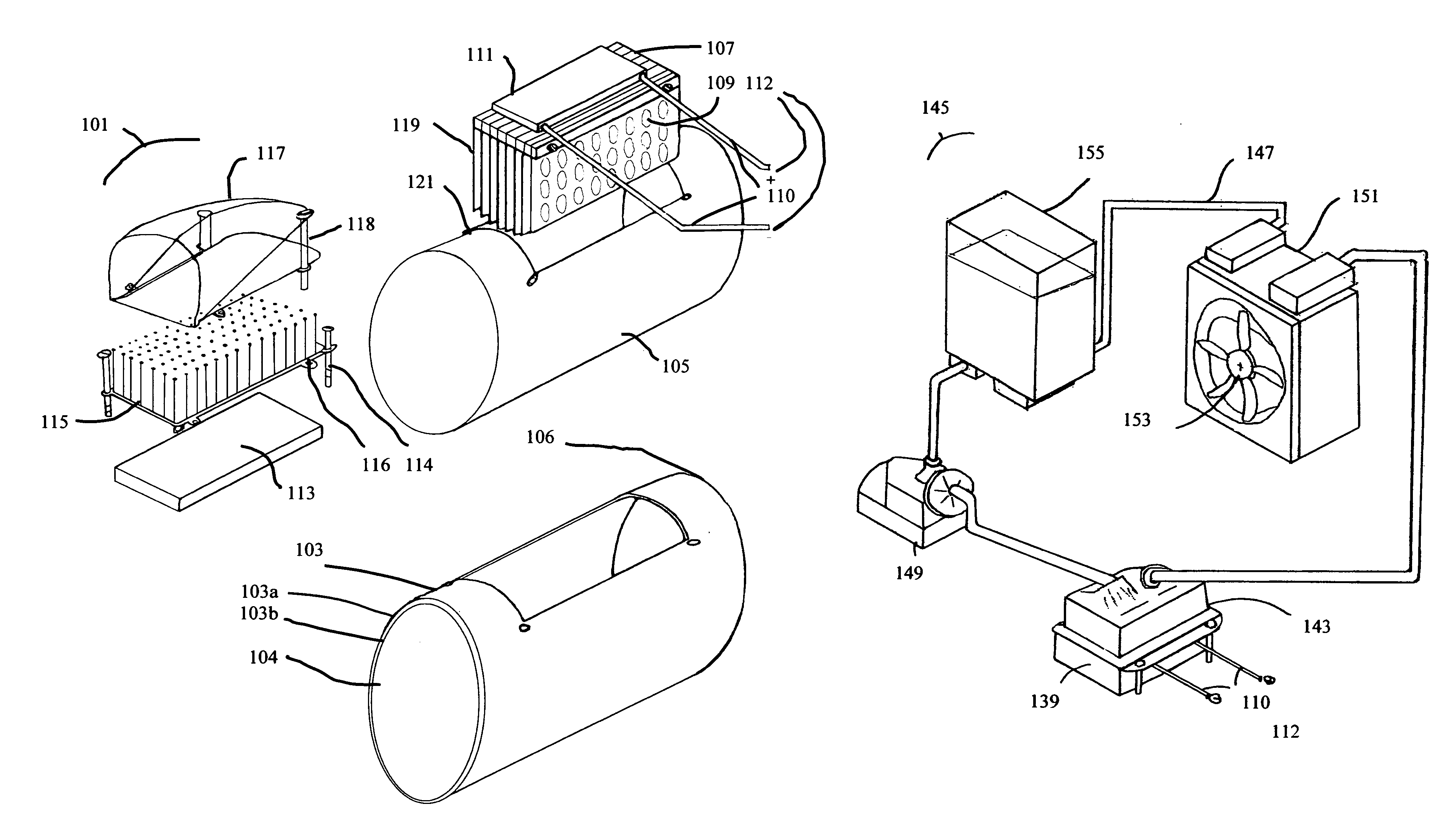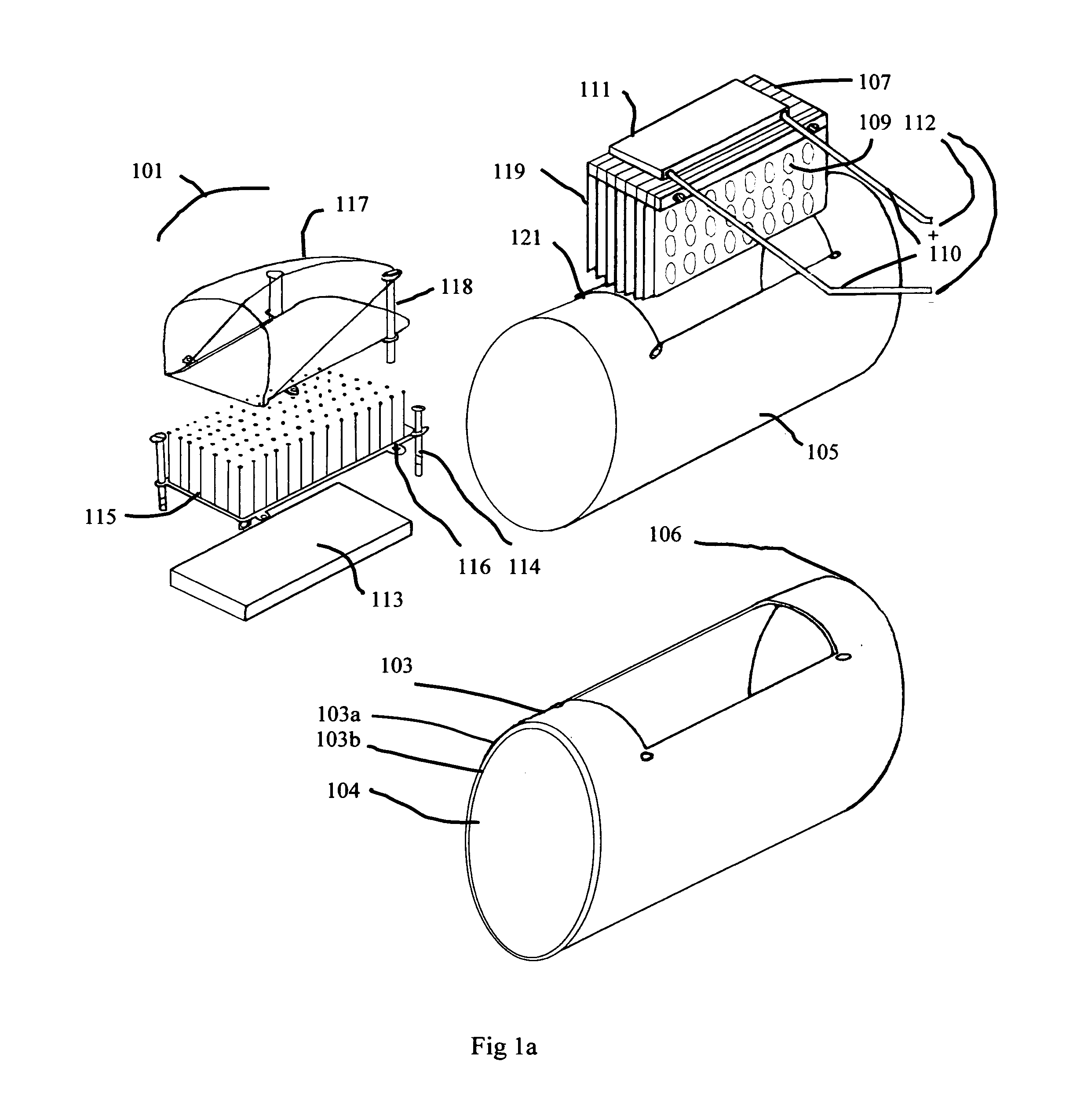Flowing fluid conditioner
a flow-flowing fluid and conditioner technology, which is applied in the direction of machines/engines, instruments, heat measurement, etc., can solve the problems of large volume exchangers with correspondingly large pressure drop, small temperature gain, and unsuitable mobile devices such as vehicles, so as to reduce fuel consumption, maintain the performance of larger engines, and reduce emissions
- Summary
- Abstract
- Description
- Claims
- Application Information
AI Technical Summary
Benefits of technology
Problems solved by technology
Method used
Image
Examples
embodiment 145
[0064]FIG. 3c is yet another alternative embodiment where direct fans are not usable (i.e. hazardous environment). A water-cooled heat exchanger embodiment 145 is employed. Exchanger 145 is comprised of water block 143, such as MCW5000T from Swiftech, power is carried over cable 110 from power source 112, gasket 139, and radiator 151 is shown. Hoses 147 such as ClearFlex 60 from Cool Technica (http: / / ww.cooltechnica.com ) connect block 143 to output of liquid pump 149 such as FloJet from PPL Motor Homes (http: / / ww.pplmotorhomes.com / parts / rv-pumps-water-filters-fixtures-1.htm#Water%20Pumps%20-%20Flojet) and radiator 151 such as Black Ice Micro from CoolTechnica Radiator 151 has fan 153 such as EC1202M12CA from Evercool (http: / / www.evercool.com) for thermal exchange. Additional hose 147 connects radiator 151 to reservoir 155. Reservoir 155 filled with water or suitable coolant has additional hose 147 connecting to input of pump 149. This embodiment allows efficient cooling and remote ...
embodiment 157
[0075]FIG. 8 depicts an on demand embodiment 157 of the invention connected to an engine 233. Air is taken in through air cleaner 217. T1 monitors temperature coming into air cleaner 217. T2 monitors fluid temperature entering conditioner 157. T3 monitors temperature inside conditioner 157. Actuator 172 is shown connected to controller 225 over actuator control / sense cable 124. Controller 225 is powered by extension of cable 110 from power source 112. CPU 209 is also powered by power source 112 over cable 110. Combiner 221 reunites bypass flow through by-pass 219 and conditioned flow from 101 (see FIG. 7) into existing throttle body 231. T4 monitors temperature-exiting conditioner 157. Throttle position is monitored existing throttle position sensor 227. Sensor 227 is connected to CPU 209 over cable 229. T5 monitors temperature of exhaust header 235. Controllers will combine the 5 temperatures (T1 through T5) and TPS values and infer engine load efficiency and requirements for condi...
PUM
| Property | Measurement | Unit |
|---|---|---|
| temperature | aaaaa | aaaaa |
| thermal isolation | aaaaa | aaaaa |
| temperatures | aaaaa | aaaaa |
Abstract
Description
Claims
Application Information
 Login to View More
Login to View More - R&D
- Intellectual Property
- Life Sciences
- Materials
- Tech Scout
- Unparalleled Data Quality
- Higher Quality Content
- 60% Fewer Hallucinations
Browse by: Latest US Patents, China's latest patents, Technical Efficacy Thesaurus, Application Domain, Technology Topic, Popular Technical Reports.
© 2025 PatSnap. All rights reserved.Legal|Privacy policy|Modern Slavery Act Transparency Statement|Sitemap|About US| Contact US: help@patsnap.com



